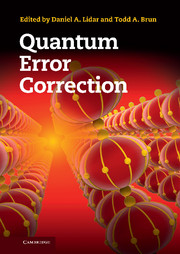Book contents
- Frontmatter
- Contents
- List of contributors
- Prologue
- Preface and guide to the reader
- Acknowledgements
- Part I Background
- Part II Generalized approaches to quantum error correction
- 6 Operator quantum error correction
- 7 Entanglement-assisted quantum error-correcting codes
- 8 Continuous-time quantum error correction
- Part III Advanced quantum codes
- Part IV Advanced dynamical decoupling
- Part V Alternative quantum computation approaches
- Part VI Topological methods
- Part VII Applications and implementations
- Part VIII Critical evaluation of fault tolerance
- References
- Index
7 - Entanglement-assisted quantum error-correcting codes
from Part II - Generalized approaches to quantum error correction
Published online by Cambridge University Press: 05 September 2013
- Frontmatter
- Contents
- List of contributors
- Prologue
- Preface and guide to the reader
- Acknowledgements
- Part I Background
- Part II Generalized approaches to quantum error correction
- 6 Operator quantum error correction
- 7 Entanglement-assisted quantum error-correcting codes
- 8 Continuous-time quantum error correction
- Part III Advanced quantum codes
- Part IV Advanced dynamical decoupling
- Part V Alternative quantum computation approaches
- Part VI Topological methods
- Part VII Applications and implementations
- Part VIII Critical evaluation of fault tolerance
- References
- Index
Summary
Introduction
Quantum error-correcting codes (QECCs) have turned out to have many applications; but their primary purpose, of course, is to protect quantum information from noise. This need manifests itself in two rather different situations. The first is in quantum computing. The qubits in a quantum computer are subject to noise due both to imprecision in the operations (or gates) and to interactions with the external environment. They undergo errors when they are acted upon, and when they are just being stored (though hopefully not at the same rate). All the qubits in the computer must be kept error-free long enough for the computation to be completed. This is the principle of fault tolerance.
A rather different situation occurs in quantum communication. Here, the sender and receiver (Alice and Bob) are assumed to be physically separated, and the qubits travel from the sender to the receiver over a (presumably noisy) channel. This channel is assumed to be the dominant source of errors. While the qubits may undergo processing before and after transmission, errors during this processing are considered negligible compared to the channel errors. This picture of transmission through a channel is similar in spirit to the paradigm underlying much of classical information theory.
- Type
- Chapter
- Information
- Quantum Error Correction , pp. 181 - 200Publisher: Cambridge University PressPrint publication year: 2013
- 2
- Cited by



